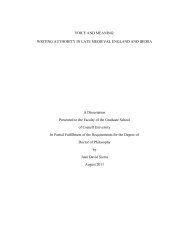CARPET WEAVERS AND WEAVING IN THE ... - Cornell University
CARPET WEAVERS AND WEAVING IN THE ... - Cornell University
CARPET WEAVERS AND WEAVING IN THE ... - Cornell University
Create successful ePaper yourself
Turn your PDF publications into a flip-book with our unique Google optimized e-Paper software.
are nuclear households because there are fewer women in each household and thus<br />
women may not be available to work outside of the home (Berik 1995, 116-117).<br />
Workshop weaving is most likely in places with distinct agricultural and non-<br />
agricultural seasons or where there are enough family members involved in<br />
reproduction of the household that some women are free to earn cash outside of the<br />
home. Under these conditions women can leave the house, and thus weave<br />
uninterrupted for extended periods of time uninterrupted (Berik 1986). Workshop<br />
weaving is more likely in extended-family households where girls can be sent out of<br />
the house as labor (Berik 1995, 116). Workshop production is most common in areas<br />
with mechanized grain-based agriculture (with a high level of landlessness and more<br />
need for non-agricultural incomes) where women don’t have to work the land and thus<br />
are more likely to work year-round in a workshop. Merchants prefer the workshop<br />
method because it increases output (Incirlioglu 1991, 258). Pay is low per piece<br />
because most of this work is done for low-quality domestic market – weaving for<br />
export gets a better price (Berik 1986, 129).<br />
Some workshops are cooperatives, organized by weavers, by the government,<br />
or by outsiders (as in the case of the DOBAG cooperatives). Government-operated<br />
Sumerhali (formerly Sumerbank) cooperatives offer health and pension benefits, but<br />
wages are very low because the carpets are sold below market prices (women work or<br />
sell their rugs elsewhere if they are able to) (Landreau 1996, 171-172).<br />
None of the three modes of production changes in cases where women interact<br />
with people outside of their kin or village. Location, however, changes a woman’s<br />
control over “labour power” (Berik 1995, 116). According to Berik, a Turkish<br />
economist, women who weave in the home do so in “spare time” and thus have more<br />
control over when they weave. Women who weave in workshops “are perceived as<br />
‘cash-generators’” and, with a separation between home and workplace, they are<br />
24

















